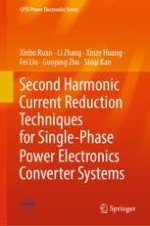Two-stage single-phase converters, including two-stage single-phase dc-ac inverters and two-stage single-phase PFC converters, are interfacing power converters between dc and ac voltage/current sources, which have been widely applied for dc-ac and ac-dc power conversion. For the two-stage single-phase converter, the ac-side power pulsates at twice the ac voltage frequency, resulting in second harmonic current (SHC) which might flow into the dc-dc converter, the dc voltage source, and dc load. This book clarifies the generation, propagation, and side-effects of this SHC and proposes the SHC reduction control schemes for the dc-dc converter, with different topologies and/or different operating modes, in the single-phase converter. On this basis, the second harmonic current compensator (SHCC) is proposed to compensate the SHC, significantly reducing the dc bus capacitance. In doing so, the electrolytic capacitors, with short lifetimes, are removed from the two-stage single-phase converter, leading to extended system lifetime and enhanced system stability. For having flawless SHC compensation performance, the port-current control schemes are proposed for the SHCC. Additionally, the stability analysis is carried out for the two-stage single-phase converter with the addition of SHCC. This book is a monograph combining theoretical analysis and engineering design, which could not only be a reference book for master students, Ph.D. students, and teachers majoring in power electronics but also be a handbook for the electrical engineers working on the research and development of LED drivers, EV on-board chargers, railway auxiliary power supplies, aviation power supplies, renewable energy generation systems, etc.
